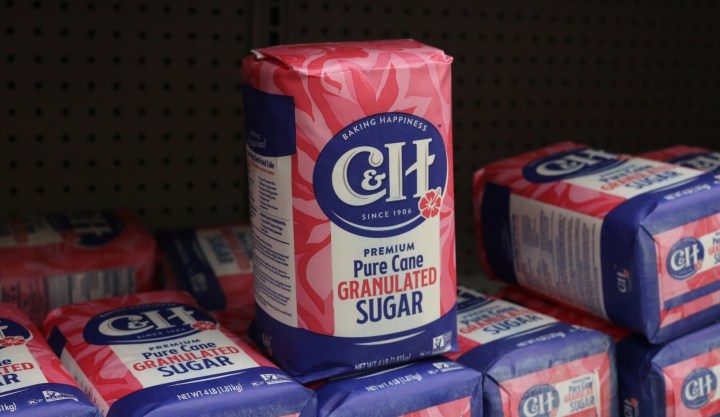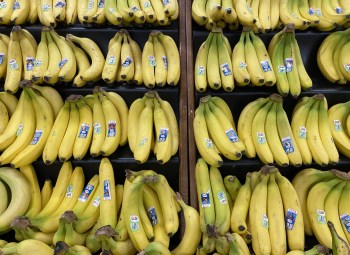
Here’s why you can’t find 5-pound sugar bags anymore
Share Now on:
Here’s why you can’t find 5-pound sugar bags anymore

Carol Gendel reached for a 5-pound bag of sugar from the grocery shelf, as she does every few months, when she immediately noticed something was off.
“Sure enough, when I checked the weight, it was 4 pounds,” Gendel wrote to Marketplace.
For at least a century, white sugar had dependably come in 5-pound bags. But for more than a decade, the pantry staple has been shrinking to 4 pounds.
Some consumers reported seeing smaller packages at their grocery stores in 2009, while others spotted changes in 2011 and 2012. In some cases, shoppers noted that the 4-pound bag was more expensive per ounce, a case of shrinkflation — when companies decrease the size of a package while keeping it at a similar or higher price.
The refined, white sugar we use to bake and sweeten coffee comes from sugar beets or the partially refined raw sugar from sugar cane.
Just like other commodities, sugar prices rise and fall depending on supply and demand. Between 2009 and 2011, the price for raw sugar on the global and U.S. markets soared amid supply constraints in various parts of the world, including India and Brazil, major sugar-producing countries.
If manufacturers simply charged more per unit to compensate for those higher prices, it would scare off customers, explained Judy Ganes, a commodities and futures analyst and president of J Ganes Consulting.
So sugar brands shrank their packages to keep prices down.

A bitter period for the global sugar supply
Government policies in India contributed to a decline in sugar production between 2008 and 2009. An export ban led to excess sugar cane in the country, pushing down the price and prompting Indian farmers to switch to more lucrative crops.
Around this period, bad weather disrupted the sugar supply in India and Brazil, the world’s largest producer of sugar. Brazil had also been diverting a significant amount of its sugar cane supply toward ethanol production.
World sugar prices rose again in 2010 and 2011, fueled by bad weather hampering Brazil’s sugar cane supply.
In 2009, world raw sugar traded at around 12 cents per pound on the Intercontinental Exchange. By the beginning of 2010, it had reached 28 cents. Raw sugar prices began to drop, but climbed through the second half of the year and the beginning of 2011, hitting the 30-cent range. Prices also spiked again during the summer of 2011.
U.S. raw sugar prices increased as world prices did. At the beginning of 2009, U.S. raw sugar traded at about 20 cents per pound. By the end of the year, it was trading at 33 cents per pound, and even climbed to 40 cents at some points in 2010 and 2011.
Our grocery store shelves reflect rising raw sugar prices. In the United States, the retail price for white sugar peaked at about 92 cents a pound in 2011, according to government data that’s been adjusted for inflation.
It eventually declined, although the price has fluctuated over the years and has been rising since the beginning of the COVID-19 pandemic. The average price so far this year is 87 cents a pound.
U.S. producers supply the majority of sugar used in this country, according to the American Sugar Alliance. But as part of the nation’s sugar import program, other countries are allowed to export a certain amount of raw and refined sugar to the U.S. at a low tariff rate set by the Department of Agriculture.
“If the world price of raw sugar is low (generally below 16 cents per pound), countries that export sugar to the U.S. need little additional incentive to sell it here because U.S. prices are high enough to be above the price and marketing costs of sales to some other country,” explained Steve Haley, a commodity analyst for the USDA.
Marketing costs include transport shipping and brokerage and administrative fees, among other expenses, Haley said.
When the world price of raw sugar rises above 16 cents per pound, U.S. raw sugar prices will rise in response.
“If the U.S. needs the sugar, the price it pays has to attract sugar away from other customers in other countries who can purchase the sugar at the prevailing world price,” Haley said.
Raw U.S. sugar is already consistently higher than the world price, sometimes even more than double the amount. That’s because the U.S. government sets a high price for raw sugar and lends money to sugar processors to help them buy it from U.S. farmers. The U.S. also imposes higher tariffs on imported sugar that exceeds a quota.
Sugar brands explain their smaller packages
With sugar prices rising, private labels and name brands like C&H Sugar and Domino reduced their packaging size, which didn’t get past observant consumers.
C&H Sugar, a subsidiary of American Sugar Refining, addressed shoppers’ concerns on the smaller packaging on Facebook in 2011:
“As you may be aware, the price of sugar on the world market has nearly doubled since the end of 2008. … In order to keep the cost per bag of sugar down, many retailers converted their store brand product from a 5-pound to a 4-pound bag. In an effort to maintain affordability we decided to do the same with our C&H® brand sugar. The reduction in size, however, is not enough to offset the cost increase in the remaining four pounds of the product. That’s why you’re seeing the price go up and the size go down at the same time,” C&H wrote.
Domino Sugar, another ASR subsidiary, also switched to 4 pounds back then and gave a similar explanation on Facebook and Twitter.
A Kroger representative told Marketplace the company stopped selling the 5-pound version of its in-house label a few years ago, although the change had been underway for about a decade.
“To keep the cost-per-bag of sugar down, Kroger began transitioning from a five-pound bag of sugar to the four-pound size in 2014. This move aligned the company’s Our Brand sugar sizing with many other retailers who also converted to the smaller size. We fully discontinued the larger size in July 2020,” the spokesperson said.
Shoppers have taken to social media to bid farewell — and lament — the loss of the 5-pound bag.
“We cooks and baking enthusiasts have seen this wily tactic of the food industry a lot throughout the last 20 years,” said one Reddit user.
“I am going to miss the 5 lb. bag – I do all my own baking. It is like the demise of the 25 lb. bag of flour. Just one more inconvenience,” wrote another user on Domino Sugar’s Facebook page.
There’s a lot happening in the world. Through it all, Marketplace is here for you.
You rely on Marketplace to break down the world’s events and tell you how it affects you in a fact-based, approachable way. We rely on your financial support to keep making that possible.
Your donation today powers the independent journalism that you rely on. For just $5/month, you can help sustain Marketplace so we can keep reporting on the things that matter to you.


















